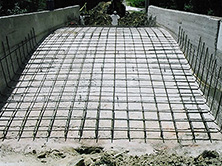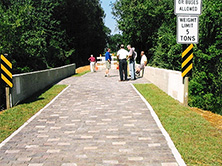 New Bern Preservation Foundation restoration of Caswell Branch Bridge (Craven County Bridge 187) in progress, ca.2009 (Preservation North Carolina)
New Bern Preservation Foundation restoration of Caswell Branch Bridge (Craven County Bridge 187) in progress, ca.2009 (Preservation North Carolina) The North Carolina Historic Bridge Inventory, completed in 2005, recommended 204 highway bridges as meeting the standards of historic significance and integrity of the National Register of Historic Places.
Before the inventory, the N.C. Department of Transportation did not have information on the total number of historic bridges in its care and their distribution about the state, much less detailed information on individual historic bridges. This lack of information made it difficult to place the bridges within historical context, and decisions about the significance of any particular bridge were often impossible.
With the inventory of the 5,000-plus bridges built before 1961, NCDOT and its partners in the State Historic Preservation Office and the Federal Highway Administration have a useful tool to help guide their preservation decisions and to implement the procedures for protecting historic resources under the applicable legislation. The inventory is also a marvelous snapshot in time, documenting older bridges throughout the state.
Challenges remain. If the history of North Carolina's highway bridges during the 20th century teaches a lesson it is that transportation networks are dynamic systems, constantly changing to meet new traffic demands and safety standards.
The highway improvement campaigns that began in the late 1910s and continued through the '50s nearly wiped away the bridges of an earlier era. By 1960, less than 10 covered bridges remained in North Carolina. Today, the number has dwindled to one. As time passes, other examples of the state's bridge building legacy might be lost. For example, the number of pin-connected, metal-truss bridges is perilously small.
Fortunately, during the past 30 or more years sensitivity to preserving historic bridges has increased. For federal projects, legislation exists that requires consideration of alternatives that will not harm historic resources. The NCDOT employs specialists who see that projects involving historic bridges or other historic sites receive vigorous and thorough review in consultation with the State Historic Preservation Office and other federal agencies where relevant.
 Caswell Branch Bridge and Old Pollocksville Road following restoration, ca.2009 (Preservation North Carolina) In the end, much comes down to costs and available options. What alternatives exist that will preserve the historic bridge while maintaining public safety and the efficiency of the highway system? Are these costs and options prudent and feasible? The answers to these questions usually point to one of five options.
Caswell Branch Bridge and Old Pollocksville Road following restoration, ca.2009 (Preservation North Carolina) In the end, much comes down to costs and available options. What alternatives exist that will preserve the historic bridge while maintaining public safety and the efficiency of the highway system? Are these costs and options prudent and feasible? The answers to these questions usually point to one of five options.
First, do nothing at all, but that often works only where traffic volumes are low and the bridges are in good condition.
Second, build a new bridge without removing the historic one, either maintaining it in local service or closing it, an option that does not resolve the problems of long-term maintenance costs and safety.
Third, rehabilitate the bridge without affecting the historic integrity or qualities that make it significant. This option has become increasingly viable as engineers have worked out many cost-effective ways to rehabilitate bridges and to meet modern standards, especially for bridges on low-volume roads where the standards have greater flexibility.
Fourth, relocate the historic bridge to a new site, an option that is only viable for a limited number of bridge types, trusses particularly, and which requires finding a new owner willing to accept responsibility and maintenance. NCDOT has had some notable successes with this approach, relocating truss bridges to pedestrian trails.
Fifth, recording the bridge for posterity before demolition if no other option is viable. This last option is not ideal, but it is hoped that the information now on file at the NCDOT and the State Historic Preservation Office — part of which is included within this website — will provide a permanent record of the state’s historic bridges and spur efforts to save them.